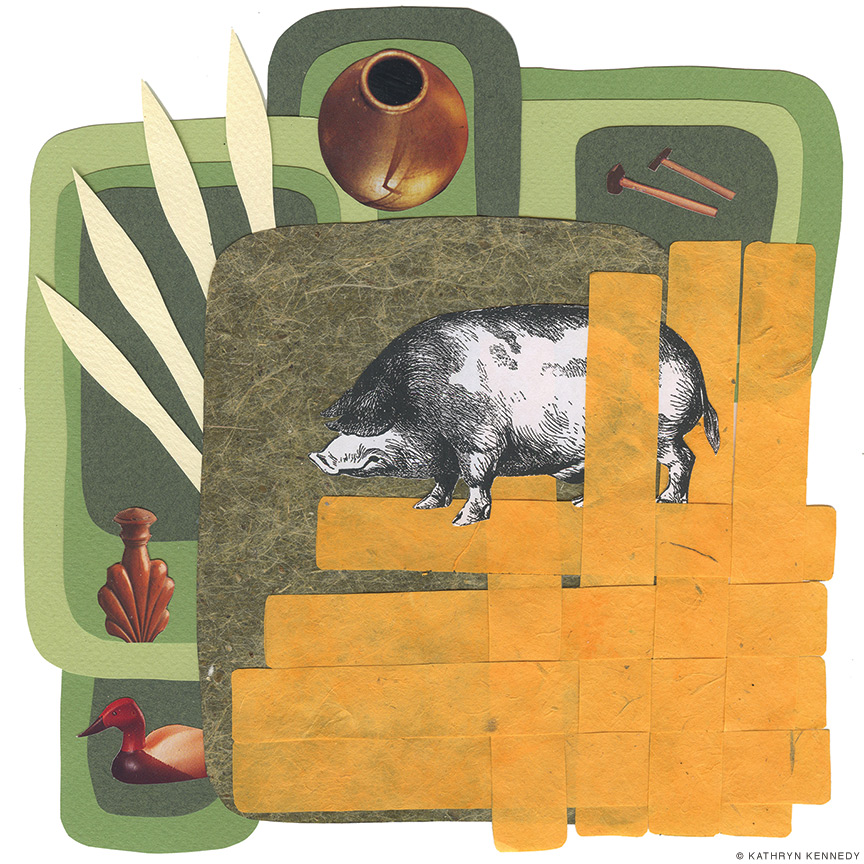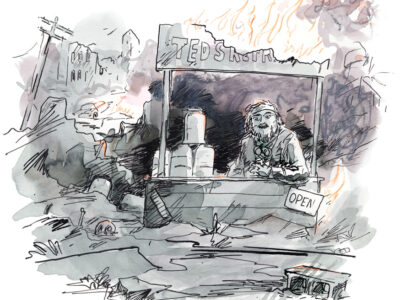
An ode to the country yard sale.
By Nick Lyons
Yard sales were a summer staple when we lived in the country. You could check any local newspaper from May through September and be sure to find dozens of ads for weekend sales. The sales could be dull or pleasant or exciting but they were always rife with surprise. You might find anything. Woodstock, New York, where we lived, teemed with yard sales. We didn’t need any of the stuff, of course, and neither did the sellers—who, after all, were ridding themselves of it. Yet the ads were irresistible to a yard-sale addict, of which I was one, as was my late wife, Mari, who called the whole business “redistributing the junk.”
Both of us were new to upcountry life, mad for it, and loved the little ritual of our weekend excursions. Sometimes there was merely a distressed table, some plastic children’s toys, a rickety chair or two. But there were also full yard and lawn bazaars in which half a dozen families—or more—unburdened themselves of all that was redundant in their lives, trying to convert junk to coin.
What would we find? Would this stuff yield the secrets of other lives?
At various times we bought scarves, a kimono that cost more to repair than we paid for it, plates (most chipped), a Paloma Picasso pocketbook, a raggedy quilt, a busted spinning wheel, an old carousel horse, an antique easel and three cheap metal ones, two sculpture stands, a fainting couch, books and books and more books, two end tables, well-used trout flies, a trout net, an old locked fly reel, three usable chairs, several hammers, a plumber’s wrench, four rusted pocket knives, a lot of paste jewelry that Mari festooned her models with, a shoebox full of low-value European coins, assorted spoons, forks, and knives, a batch of candlesticks, a large broken candelabra—all of them emblems of lives paring down or gone, folks relocating to San Miguel, Tahiti, or the next county, out of overflowing basements or garages.
Most of it slept in closets or on crowded tables, though Mari’s studio reaped an infusion of stuff for still lifes or studio scenes, and she had always wanted to pose a model on a genuine fainting couch. We were rarely early birds. We preferred to lose the choice worm and the crowds, arriving instead at an hour conducive to giveaway prices. We never went too far afield—not wanting to lose too much of a bright summer day—though an enticing ad could tempt us as far as four towns to the west. Tools always interested me, though I have three thumbs. We bought shelves full of local crafts, and many ceramic pots and bowls when we found them. But books were always the greatest prize. We were shrewd and picky about books—tight about price and condition as well as title and edition. One permanent yard sale had nearly 100 books, week after week, and we got excellent buys from it until the owner asked what I prized. I told him about first editions, and soon silly books were overpriced because, he told me, they were first editions. We once followed a trail to an advertised cache of “great books” only to end up buying a box of 48 canning jars, of which we used exactly two, four years after carting them home.
We looked for hints in the ads that an odd item might indicate a cluster of similar but better items; an easel might herald the presence of brushes, studio props, palette knives, frames, abandoned canvas. But we soon learned that coming upon the unexpected, in unexpected places, was more probable. We often visited a place called simply “Garage,” run by a good-natured guy named Jimi, from whom we had bought a cement rooster, a Buddha head, and a couple of fishing lures. One year we could not agree on the price of an abstract marble sculpture, priced much higher than his usual fare. After Jimi said he’d sold it for nearly a thousand dollars I became absolutely convinced, and lost sleep over the thought, that it had been a Brancusi.
At a yard sale we never looked for a particular item the way one would go into a Target or a Macy’s. What you want is the shock of the unimagined. You want a glimpse into a neighbor’s life. You want to understand a bit more about this disparate world of rural America that you have come to love. You revel in the thousand occasions for hope. You will find that spoon with the exact configuration of the one you used so comfortably for soup in another country. An old weathervane, a hall mirror, an oak umbrella stand, a bamboo fly rod, something large or small, needed or not needed, to fit into some arcane corner of the scheme of your life, something that for whatever reason you just can’t live one more hour without.
Some autumns ago, on the last day of yard sale season, I screeched to a halt on Route 28, made a hazardous U-turn, and pulled up to four or five tables and bookcases. The books had drawn us and they proved an eclectic stew: romances by the yard; old Reader’s Digest books (I’ve always preferred getting all the words); books on natural healing; on brothels in Butte, Montana; on juicing; and one called Harris on the Pig. This last was irresistible and I was happy to get it—and, a few years later, to publish a new edition of the century-old classic on pig farming; I reprinted it 11 times at my little press. Mari settled gleefully on a spotted wooden cow with udders that wiggled—offered as a piece of “authentic Catskill folk art.” I shook my head when she forked over $11 for the cow after a customary round of bargaining.
In the car she was deliciously pleased with her purchase. I showed her the hammer that I bought for $1 along with the pig classic. I have four others, similarly purchased. But how could I pass up such a tool, with such a fine tawny patina and exactly the right heft?
“Starting a hammer collection?” Mari asked blithely.
I did not respond—nor did I offer one word of praise or wonder about the authentic Catskill folk art with the wandering udders.
Nick Lyons W’53 is a longtime Gazette contributor.




